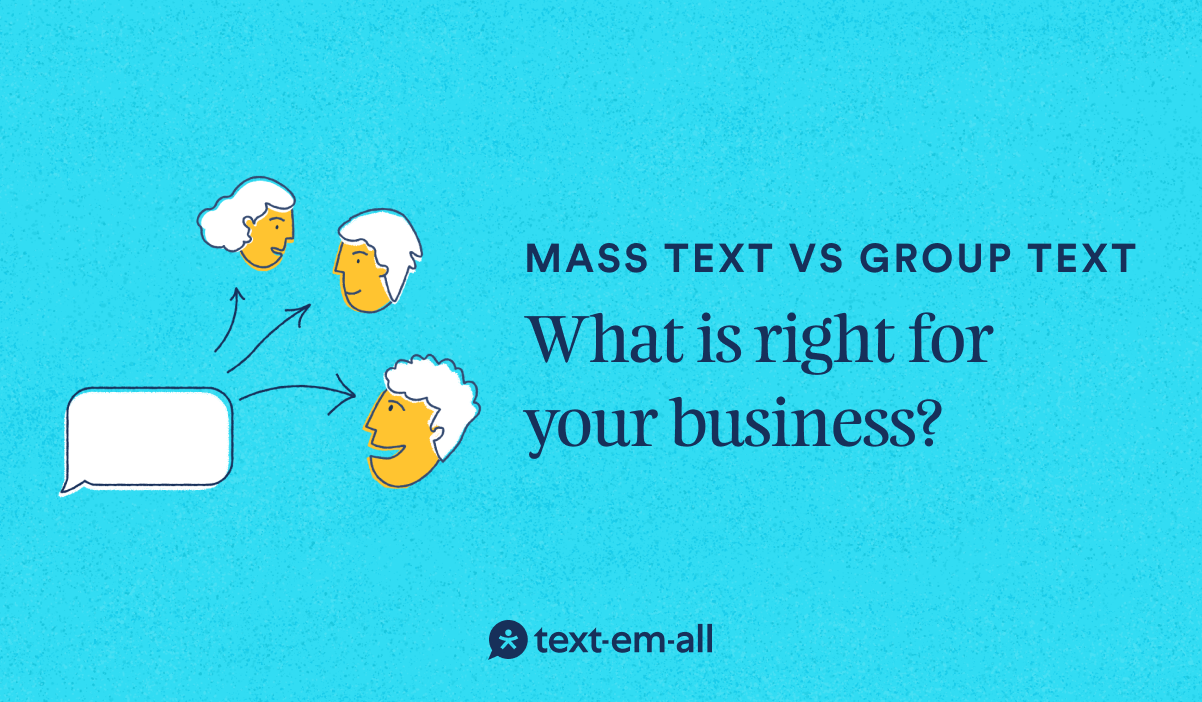
Effective communication is crucial, whether for personal or business needs. Mass text and group text are both common methods for reaching multiple recipients at once, but they answer different needs. So, how do you choose between the two?
Understanding the nuances between group and mass texts can significantly impact your business communication strategy. So, let’s explore the key differences between the two to help you make an informed choice for your specific needs.
Jump straight to:
What is Group Texting
A group text is sent to at least three people simultaneously. In group text messaging, all participants can view and respond to each other’s messages. This makes the method suited for various purposes in professional settings, including:
- Coordinating activities
- Organizing events
- Exchanging information
- Sharing updates
- Staying connected
Characteristics of Group Texting
Group messages are typically sent as an MMS (Multimedia Messaging Service), so they can include multimedia content like images, video, QR codes, and more.
One of the biggest limitations of group messaging is that there is a limit to how many people can participate. This depends on your carrier and mobile phone, but most cell providers only allow 20 to 30 people in a single group message.
Another key trait of group messages is that each recipient can see others' replies. This can result in misunderstandings or accidental disclosures of sensitive information. And even if personal information stays discreet, the constant flood of new messages and notifications is more likely to hurt customers’ brand loyalty instead of fostering it. Lastly, it can be unrealistic for businesses to manage timely responses for large groups.
Advantages of Group Messaging
When considering whether to send a group text to your business’ contact list, ask yourself:
- Do recipients benefit from interaction and feedback? Group text messaging encourages interaction by enabling real-time communication among multiple participants. This can inject a healthy dose of dynamism, creating an atmosphere for collaboration, brainstorming, and idea exchange.
- Do multiple recipients need centralized coordination? Because everyone can see others’ replies, the potential for miscommunication is reduced. This makes organizing and coordinating plans or projects easier and keeps everyone on the same page.
- Does cost matter? – Group messaging is often the cheapest option for small groups since almost every phone supports it, even though sending one message to ten people costs as much as sending ten separate messages.
Disadvantages of Group Messaging
If the following considerations will significantly impact your communications, you probably want to implement a mass texting platform instead:
- Limited audience size – This is arguably the biggest disadvantage of group SMS messaging—there are real limits to how many people can participate. As your business grows and your SMS list gains more contacts, managing multiple group chats becomes challenging.
- Potential for message overload – Consumers prefer SMS communications over other methods. However, too many messages generally have a negative effect, leading to disengagement. In a flood of messages, important details get lost, and participants may be inclined to tune out and miss important information.
- Privacy must be maintained – Again, privacy is a serious concern when it comes to group messaging. The more people there are in a texting group, the higher the chances of inadvertently sharing sensitive information.
To wrap up, SMS group messaging can be a solid solution when the number of participants is smaller, given that privacy is addressed carefully. But it’s more suited for internal communications when coordinating a small team than engaging with your audience.
What Is Mass Texting
Mass texting is the process of sending an SMS to a large number of people at once but not within the same thread. It enables organizations to quickly and efficiently reach their entire audience or specific segments. Among else, businesses use mass texting to communicate with customers, send alerts and notifications, promote offers, or send out invitations to events. Mass texting enables businesses to enhance and optimize consumer engagements on a level that group texting simply cannot compete with.
Characteristics of Mass Texting
Unlike group texting, you cannot send a mass text straight from your phone, so you’ll have to use a mass texting platform, like Text-Em-All, to automate and streamline this process. These solutions come with a wide range of other capabilities that benefit businesses and keep customers engaged and satisfied.
For example, they offer personalization of mass text messages to each recipient. This is crucial to success, as the available data shows that 72% of recipients prefer messages crafted specifically for them. Similarly, 97% of marketers report improvement in business results due to personalization efforts.
Mass texting platforms also simplify management—one of group texting’s biggest disadvantages. Platforms offer automation and scheduling features, which can improve the overall effectiveness of a texting campaign. They also have analytics and reporting capabilities that provide useful insights and help you refine your strategies further.
Advantages of Mass Texting
The reasons to choose mass texting to communicate with your audience generally come down to:
- The message or campaign requires a broad reach – There is virtually no limit to how many people you can reach with mass texting, which makes it advantageous to group messaging.
- The information sent requires timely action – Mass texting is a highly efficient way to broadcast information quickly and at scale. 98% of texts get opened, and when recipients respond to SMS messages, 90% do so within three minutes.
- High customization and automation potential – With a mass texting platform, you can extensively personalize and automate texting campaigns. This allows you to blast hyper-targeted messages quickly and effortlessly. SMS campaigns often leverage personalization and compelling calls to action (CTA) to drive engagement.
Disadvantages of Mass Texting
Before sending out a mass text, however, remember to consider:
- Regulatory and compliance obligations – Mass texting is 100% legal, but strictly regulated. For example, according to the Telephone Consumer Protection Act, companies must provide consumers with an easy opt-out mechanism and record their contacts’ consent. However, SMS platforms like Text-Em-All can can help you navigate SMS compliance, taking away the complexities.
The advantages mass texting provides to businesses generally outweigh the disadvantages, as long as you have the right platform implemented.
Mass Text vs Group MMS
Let's quickly compare mass texts vs group texts across four key factors.

#1 Audience Size and Scalability
Mass texts are clearly the winner for this comparison, as only a relatively small number of individuals can participate in a group text. And even if it weren’t for carrier-imposed limitations, managing all the messages among large groups would quickly become impossible.
#2 Privacy and Control
As discussed above, group messaging has inherent privacy vulnerabilities that cannot be addressed easily. Everyone receives every message whether participants want to or not because they’re all participating in the same conversation. Conversely, mass texting platforms make each individual conversation unique, guaranteeing privacy and allowing more personalization.
#3 Audience Interaction Dynamics
If you want to encourage discussion among your audience, group texts are better than mass texts because they allow everyone to interact and communicate with each other. However, moderating the conversation will likely see better results on a dedicated social media channel, like a Facebook Group.
#4 Technical Features and Requirements
Mass texts provide far superior technological capabilities because they depend on a specialized platform, like Text-Em-All. The automation, personalization, keyword, and analytics features that help tweak and optimize future campaigns simply don’t exist for group texting.
How to Choose Between Mass Text vs Group Text
The differences between mass texting and group texting are stark, but it can still be challenging to choose between these two options.
For some organizations, group messaging may seem more convenient and cost-effective because it’s provided natively with virtually every mobile phone. It is ideal for smaller, more cohesive groups requiring back-and-forth communication. It's suitable for team coordination, event coordination, or any scenario where everyone's input is valuable.
Mass text is best used for reaching a large audience where potential responses are kept private, and recipients can’t see each other’s replies. It's ideal for marketing, customer engagement, internal communication, event management, emergency notifications, and appointment reminders, where personalization and privacy are key.
The bottom line is that both group messages and mass texts have their place in business communications. Group messages have the dynamic and interactive element mass texts cannot have but lack the scalability inherent to mass texts, and vice versa.
Try Mass Texting With Text-Em-All
Almost everyone owns a smartphone, and every smartphone has a built-in SMS app. So, there isn’t an organization that wouldn’t benefit from implementing a communication strategy that utilizes text messages. It’s one of the most prevalent, timely, and effective forms of communication available today.
With Text-Em-All's intuitive platform, you can send mass text messages to any group size in a personalized and resource-efficient manner.
Create your free account with Text-Em-All today. We don’t have any contracts, and we offer two different plans so that you can choose what meets your needs.












